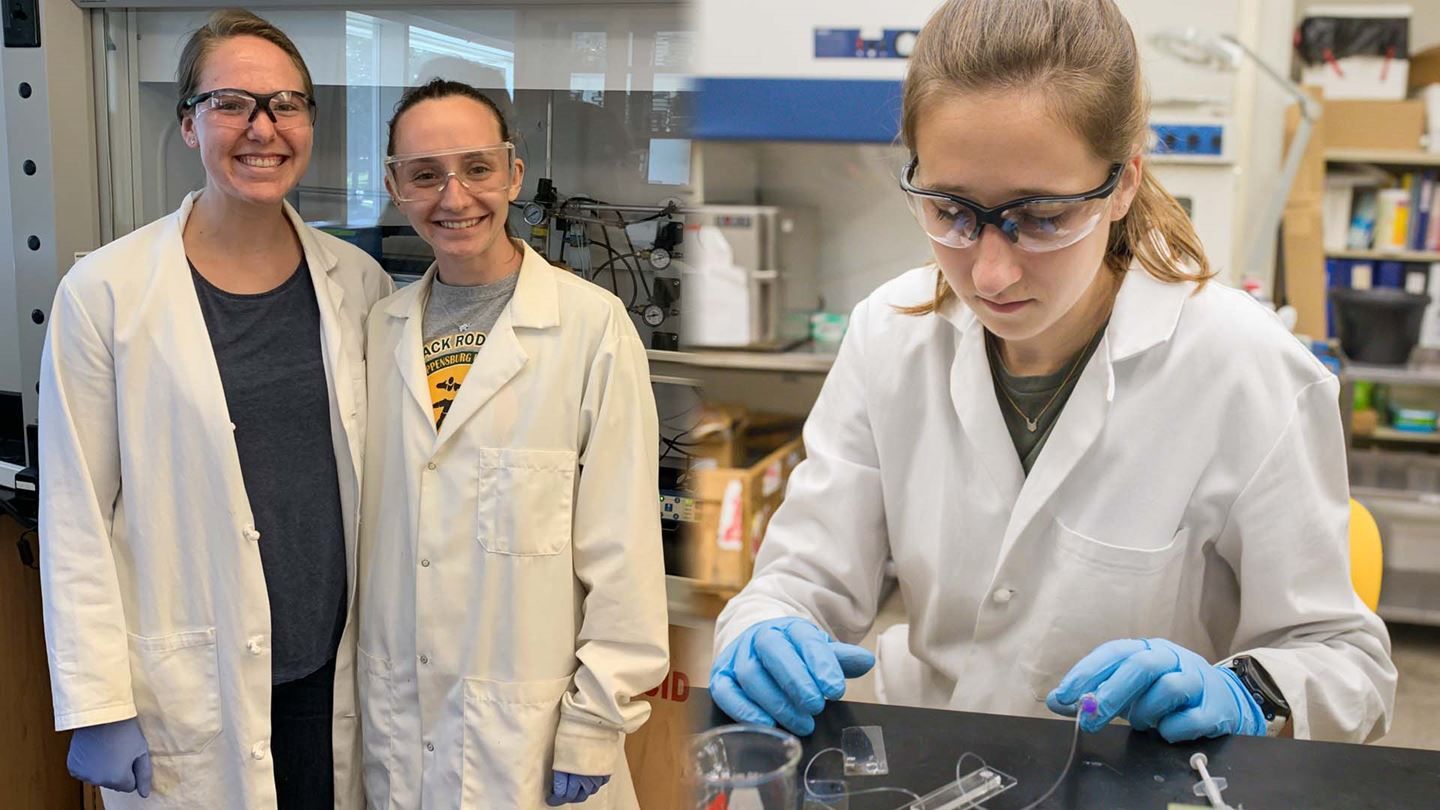While at Lehigh, rising seniors and student athletes Ashleigh Crawford (bioengineering; cross country/track), Diana Hammerstone (materials science and engineering; cross country/track), and Sarah Boyer (materials science and engineering; rowing) have been empowered to succeed in the engineering field. All three are on campus this summer, thanks to the prestigious Clare Boothe Luce program, a national program that identifies high-achieving women engineers to conduct advanced-level research.
Last fall, Crawford was trying to figure out what she wanted to do post-graduation.
"The options seemed to be either go into the industry or graduate school," she says. "I wanted to branch out and get the experience of working in an academic lab to see if grad school was something I wanted to pursue. That's why I applied for the Clare Boothe Luce scholarship."
Crawford was in the lab this past spring semester and will continue her research through next spring semester as part of Xuanhong Cheng's lab. Cheng is an associate professor of bioengineering and materials science and engineering.
"My main project is a microfluidic device (which deals with the behavior of fluids), using a temperate gradient to separate out nanoparticles (small particles)," says Crawford. "Our solution runs through the device, which is set up in between a hot and cold plate. In the end, there are three different channels; one channel is more concentrated, one channel is more dilute and the third channel is in the middle." There's a lot of research going into exosomes and their therapeutic abilities, so this process could help salvage them.
"The microfluidic device has been worked on for a few years and we are adapting it to different solutions," says Crawford. "In the past, it was used to separate out viruses such as HIV, whereas now, we're trying to have it separate out a different biological material."
While Crawford wasn't sure if she was interested in research, Hammerstone has had a longer-standing passion for it.
"I started research with Professor [Lesley] Chow last summer because I had taken her class and was interested in her lab," says Hammerstone. Chow, an assistant professor of bioengineering and materials science and engineering, later suggested Hammerstone apply for the Clare Booth Luce program.
"Our lab works with modular biomaterials (materials that have been engineered for a medical purpose) for tissue engineering," Hammerstone says. "I'm figuring out how we do this with a greater number of materials, so we can meet the needs of different applications. I work mostly with 3-D printing with polymers (large molecules with repeated subunits). I'm helping to figure out the properties of the polymers, which help us figure out how to print with them immediately…rather than trial and error, which takes time."
Essentially, 3-D printing is the mechanism used to study the properties of polymers.
"We do solvent cast 3-D printing, basically meaning we put polymers in a solution, which is like our ink. Then, we put it in the printer," says Hammerstone. "We later extrude (force out) that solution, the solvent evaporates and we're left with a polymer."
Boyer has had an interest in graduate school for some time, so her summer research is helping her prepare for the future.
"In the fall, I went up to Professor Chow and asked if she had any room in her lab for me," says Boyer. "She said yes; she started this project with another professor, Professor [Helen] Chan and they wanted me to be the undergraduate working on the project." Chan is New Jersey Zinc Professor of Materials Science and Engineering.
Boyer is currently using the capabilities of both labs in her daily research.
"The Chow lab 3-D prints, so I'm 3-D printing metal oxide powders in a polymer ink to make structures," says Boyer. "The goal is to reduce those structures to form high entropy alloys (alloys that are formed by mixing equal or relatively large proportions of five or more elements). Basically, I'm 3-D printing metal oxides, then you put it in an 'oven', it gets rid of the oxygen and you're just left with a metal structure."
Boyer's end goal is to find a new way to construct high entropy alloys.
"High entropy alloys are new types of alloys that have very interesting properties and contradict things that everyone believed were true in material science," she said. "They're usually created through a casting process, but we're trying to create a new manufacturing way to make different combinations of these alloys."
Crawford, Hammerstone, and Boyer may be working on different labs, but there are plenty of common themes between everyone.
Most importantly, each are motivated individuals who have found an area of passion.
It's showing.
"It doesn't feel like I'm at a job," says Boyer. "I'm working 9 a.m. to 5 p.m., but it doesn't feel tedious or boring. I believe it's the same with athletics. There are definitely points when it's hard, but I still love what I'm doing so it makes everything worth it."
These student-athletes have learned that whether it's in the classroom, lab or competing in athletics, hard work and success are highly correlated.
"You get out of cross country/track what you put in, and it's the same thing with research," says Hammerstone. "If you put the hours in, you're going to collect a data set you can use for something. Keep at it and you're going to eventually get the data you need."
Read the full story on the Lehigh Athletics website (LehighSports.com).
Story by Justin Lafleur, Lehigh Sports Communications

